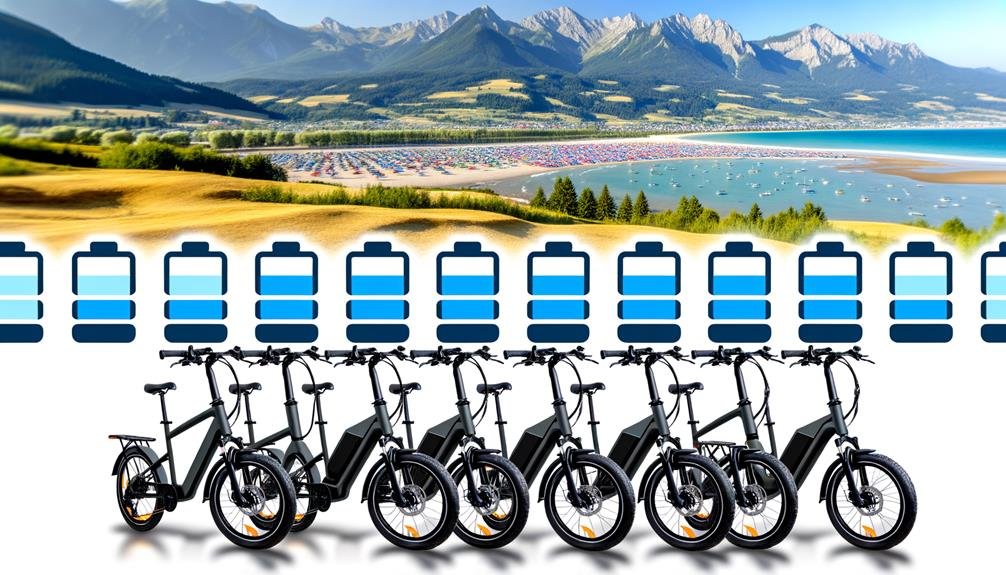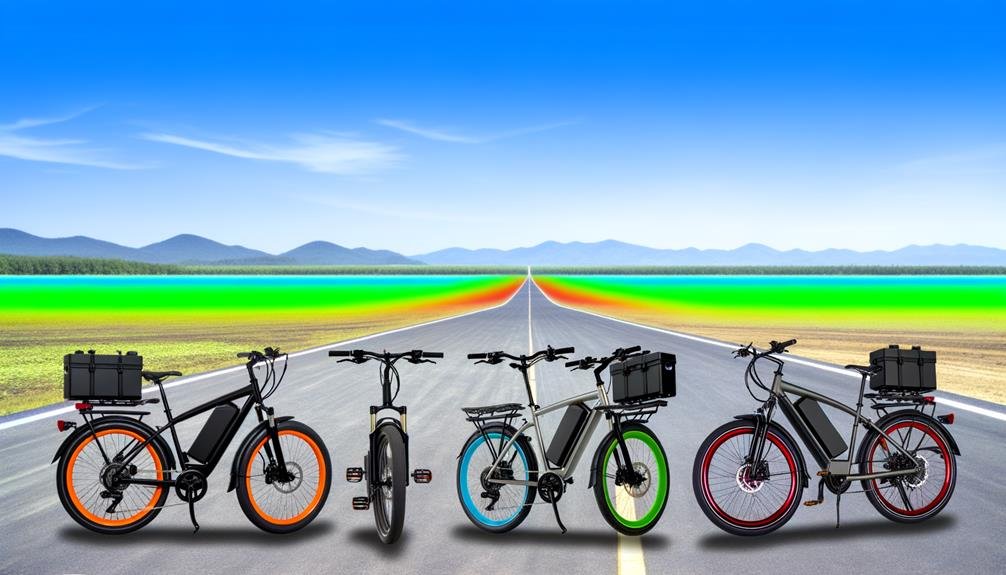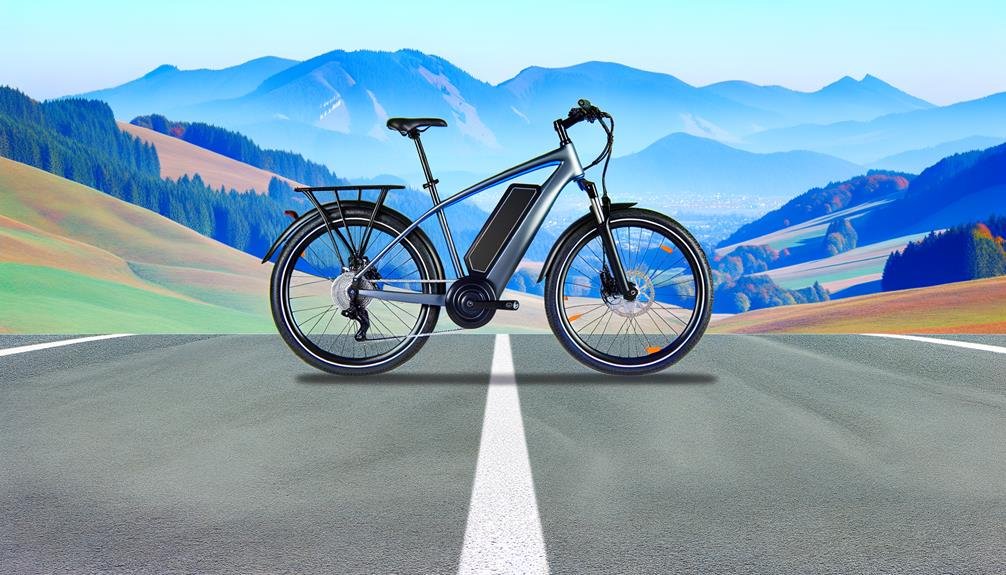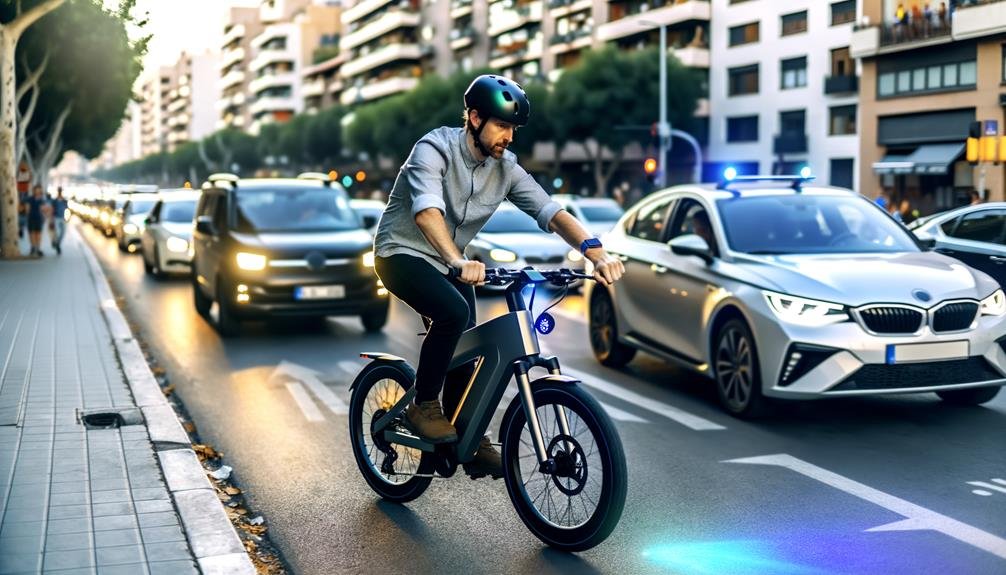Charles Miller is a veteran bike enthusiast with over 12 years of experience dealing with bikes as a mechanic. Despite immense love and expertise for...
In the realm of electric bikes, or e-bikes, the question of range isn't just about numbers, it's about freedom. We're talking about the ability to go further, explore more, and worry less about where the next charge is coming from.
There's a smorgasbord of models out there, each boasting different capabilities and features, but which one truly goes the distance? Is it the Fuell Flluid 2, the Optibike R22 Everest, the Watt Wagons HOUND, the EUNORAU Flash, or the Juiced HyperScrambler 2?
Let's embark on a journey to unravel this intriguing question, and along the way, you might just discover your perfect e-bike match.
Key Takeaways
- Fuell Flluid-2, Optibike R22 Everest, Watt Wagons HOUND, and EUNORAU Flash are electric bikes with the longest range, ranging from 200 to 225 miles.
- Battery capacity and efficiency, as well as the design of the electric motor and system, are crucial factors that affect the range of electric bikes.
- Lighter e-bikes tend to provide longer range due to increased efficiency, while heavier e-bikes use more energy and have reduced range.
- Terrain and weather conditions, such as hilly or rough terrain, strong headwinds, and cold temperatures, can significantly impact the range of e-bikes.
Understanding E-Bike Range
To truly grasp the concept of e-bike range, we must delve into the specifics of battery capacity and efficiency, as exemplified by models such as the Fuell Flluid-2, Optibike R22 Everest, Watt Wagons HOUND, EUNORAU Flash, and Juiced HyperScrambler 2. These long-range electric bikes redefine 'longest range', stretching miles per charge to new limits.
Fuell Flluid-2, for instance, offers up to 225 miles on a single charge, thanks to its dual-battery system totaling 2 kWh.
Optibike R22 Everest, on the other hand, boasts a massive 3,260 Wh battery, justifying its hefty price.
The Watt Wagons HOUND, with a 200-mile range, demonstrates the potential of a supercharged model with a 3,210 Wh battery capacity, compatible with electric car charging stations.
Similarly, the EUNORAU Flash achieves up to 220 miles range, courtesy of its three large batteries amounting to 2,808 Wh.
Lastly, the Juiced HyperScrambler 2, with close to 2,000 Wh of total capacity, offers a solid 100-mile range per charge.
Top-Range Electric Bikes Review
Having unraveled the specifics of battery capacity and efficiency in e-bikes, let's now scrutinize the top performers in this domain – the Fuell Flluid-2, Optibike R22 Everest, Watt Wagons HOUND, EUNORAU Flash, and Juiced HyperScrambler 2.
These long-range e-bikes are the best electric bikes in the market, boasting unparalleled range and power. They're the embodiment of technological advancements in the electric bicycle industry, built for those of us who crave long distance rides.
- Fuell Flluid-2: This electric bike offers an impressive range of up to 225 miles, thanks to its two removable battery packs. It's the epitome of what long-range e-bikes should be.
- Optibike R22 Everest: With 3,260 Wh of lithium-ion cells, this bike can easily conquer the steepest hills.
- Watt Wagons HOUND: Ideal for off-road enthusiasts, the supercharged model boasts a range of 200 miles on pedal assist.
Through this top-range electric bikes review, we see that these bikes are upping the ante in the industry. So, if you're pondering over which electric bike has the longest range, look no further than these exceptional models.
Factors Affecting E-Bike Range

When we talk about the range of electric bikes, several factors come into play. Battery capacity and efficiency, the weight of the e-bike and cargo, as well as the impact of terrain and weather are some of the key elements to consider.
It's also crucial to mention that regular maintenance can significantly optimize the range and overall performance of the e-bike.
Battery Capacity and Efficiency
In understanding the range of electric bikes, we must consider both the battery capacity and efficiency, as these are crucial factors that significantly influence the distance an e-bike can travel on a single charge.
- Battery Capacity: Measured in watt-hours (Wh), a larger battery capacity allows an electric bike to travel longer distances. High-capacity batteries, like the Bosch Powertube, can give an e-bike the longest range.
- Efficiency: The efficiency of the electric motor and the system's overall design impact the bike's range. Improved efficiency results in longer rides.
- Removable Batteries: Lithium Ion batteries, often removable, offer flexibility for longer rides. By carrying an extra battery, you can effectively double your range.
E-Bike Weight Implications
While battery capacity and efficiency play pivotal roles, we can't overlook the impact of an e-bike's weight on its range.
It's an undeniable e-bike weight implication that the heavier the electric bike, the more energy it uses, thus reducing the miles of range.
The weight of the rider and any cargo also influences the bike's range, pushing the drive system harder and draining the battery faster.
As such, a lighter electric vehicle, like a commuter bike, can often provide the longest range due to its increased energy efficiency.
However, it's not just about the bike's weight; managing additional load effectively can also help maximize an e-bike's range.
Therefore, considering the weight factor is crucial in our quest for the e-bike with the longest range.
Terrain and Weather Impact
Beyond the weight implications, we must also consider how terrain and weather conditions significantly affect an e-bike's range. Real-world factors like these can dramatically vary depending on location and season, impacting how many miles a single charge can last.
- Terrain Type: Hilly or rough terrain can reduce the longest range of an electric bike. This is where an optional range extender becomes invaluable, helping to maintain performance on challenging routes.
- Weather Conditions: Strong headwinds and cold temperatures can decrease battery efficiency, shortening the e-bike's range.
- Riding Style: Opting for pedal assist on demanding terrains can conserve battery, extending the e-bike's range.
Comparing High-Range E-Bike Models

Diving into the world of high-range e-bike models, we see that the Fuell Flluid 2, Optibike R22 Everest, Watt Wagons HOUND, EUNORAU Flash, and Juiced HyperScrambler 2 all provide impressive mileage, with each model boasting unique features to enhance their performance.
The Fuell Flluid 2, for instance, impresses us with a range of up to 225 miles, thanks to its dual removable battery packs.
Next is the Optibike R22 Everest, which can conquer a virtual Mount Everest on a single charge, boasting a range exceeding 300 miles with its 3.26 kWh battery.
Comparing these high-range e-bike models, we also come across the Watt Wagons HOUND. Designed for the adventurous, it offers a 200-mile range, and with the optional supercharged model, riders can expect similar mileage.
Meanwhile, the EUNORAU Flash delivers up to 220 miles with the optional three large batteries and the Juiced HyperScrambler 2, a moped-style electric bike, offers a 100-mile range with its high-capacity batteries.
In this comparison, each Bike Company Model stands out, offering an impressive range for longer, uninterrupted rides.
Pros and Cons of Long-Range E-Bikes
In evaluating the advantages and drawbacks of long-range e-bikes, we must consider factors such as extended travel distances, battery capacity, price, and the potential impact on handling due to added weight. One of the key pros is the ability to cover longer distances without recharging. The longest range electric bike can provide an impressive range, particularly when used in pedal assist mode. This is largely due to their dual battery option or high-capacity removable battery.
However, there are also cons to consider:
- Price: The advanced battery technology that allows for extended range often results in a higher price tag.
- Weight: While the battery capacity is a boon, it can add significant weight, potentially affecting handling and maneuverability.
- Charge Time: Longer range might mean longer charging times, which could be an inconvenience for some users.
That said, the sense of freedom and flexibility these long-range e-bikes provide could be well worth these trade-offs for many users. Ultimately, identifying the best electric bike for you'll depend on your specific needs and preferences.
Future Developments in E-Bike Range

Looking ahead, we're seeing substantial advancements in battery technologies that promise to push e-bike ranges even further.
Moreover, innovative enhancements are being experimented with, aimed at maximizing range without compromising on performance.
We're set for an exciting era where e-bikes will become even more efficient and capable, setting new benchmarks in distance travel.
Advanced Battery Technologies
As we venture into the future of e-biking, it's becoming clear that advanced battery technologies are set to significantly extend the range of these eco-friendly machines. We're seeing electric bikes with the longest range ever, thanks to breakthroughs in battery tech.
- EUNORAU Flash: With three batteries, it offers the longest range – up to 220 miles per charge on pedal assist.
- Flluid-2: It provides a range of 225 miles using two removable 2 kWh battery packs.
- Watt Wagons HOUND: This bike offers a 200-mile range with a 52V 60Ah pack.
These examples showcase that, while it still takes hours to charge these batteries, the future of e-biking is bright and full of possibilities.
Innovative Range Enhancements
While we're already seeing impressive leaps in e-bike range due to advanced battery technologies, what's even more exciting is the anticipation of innovative range enhancements set to push these boundaries further.
These future developments suggest limitless advancements in electric bike range. We're expecting to see higher capacity batteries and more efficient electric motors, increasing the power output and thus, the longest range of e-bikes.
Among the bikes listed for release in the coming months and years, many are predicted to offer even greater distances on a single charge. As we move forward, we'll witness the e-bike industry shattering its own world records, by adopting innovative technologies to extend range capabilities significantly.
This is an exciting time for those of us who belong to the e-bike community.
Frequently Asked Questions
Which Electric Bike Has the Greatest Range?
We're examining which e-bike boasts the greatest range. Factors like battery technology advancements, pedal assist influence, speed impact, charging infrastructure, bike weight, rider's physique, and terrain effects all play crucial roles in determining this.
What Is the Maximum Distance for an Electric Bike?
We've observed that e-bike range varies greatly, influenced by factors like battery efficiency, e-bike design, and terrain. Some e-bikes can travel over 200 miles on a single charge, depending on usage and charging factors.
Which Ebike Has 70 Mile Range?
We've found that several eBikes, depending on pedal assist levels, rider weight, and terrain, can hit a 70-mile range. Battery efficiency, charging duration, riding conditions, and proper eBike maintenance also greatly impact this performance.
Which Ebike Battery Lasts Longest?
We've found that the Optibike R22 Everest's battery lasts the longest. With advancements in battery technology, its capacity and efficient charging frequency, it offers a remarkable 300-mile range on a single charge.
Conclusion
In conclusion, the Optibike R22 Everest holds the crown for the longest-range e-bike, boasting a staggering 300-mile range.
However, factors such as terrain and rider weight can significantly impact this. For instance, a heavier rider tackling hilly routes may experience reduced range.
Despite the challenges, the potential and innovation within the e-bike industry are promising, opening up possibilities for even longer-range models in the future.

Charles Miller is a veteran bike enthusiast with over 12 years of experience dealing with bikes as a mechanic. Despite immense love and expertise for his Tacoma, he rides his Trek Ebike more. Anytime you meet him, you’ll either hear him talking about Bikes, or writing about all things bikes and cars on this blog.
More Posts


